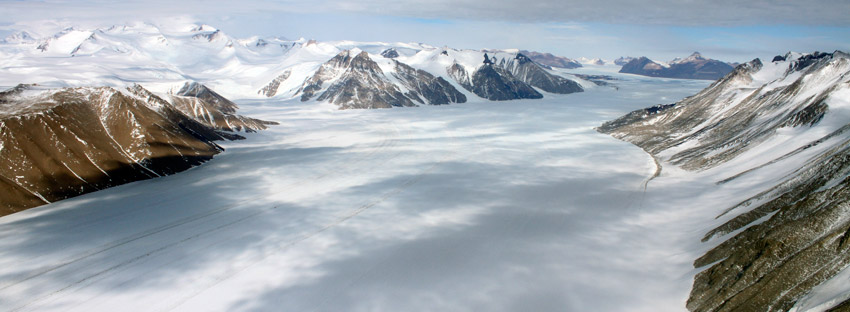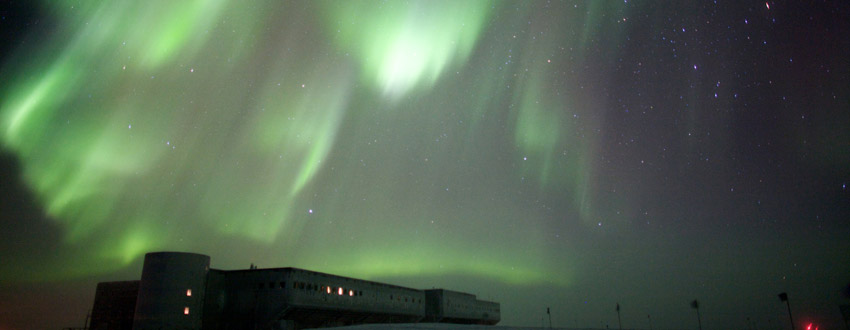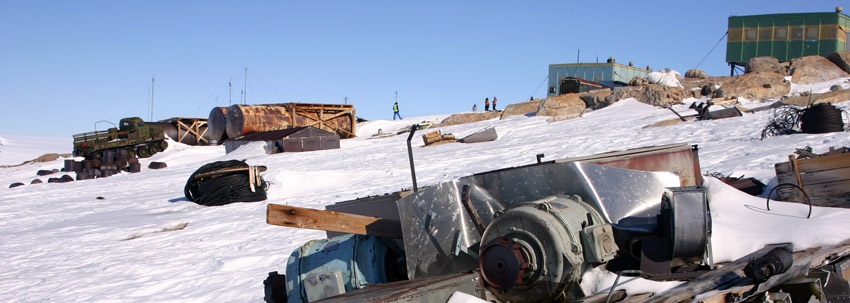80 Questions for Antarctic Science
From the 1st SCAR
Antarctic and Southern Ocean Science Horizon Scan - 2014
These are a series of questions sorted into categories of the things that scientists think are the most important things we should find out about Antarctica in the short to medium term.
July
August
September
October
November
December
ANTARCTIC ATMOSPHERE AND GLOBAL CONNECTIONS
1. How is climate change and variability in the high southern latitudes connected to lower latitudes including the Tropical Ocean and monsoon systems?
2. How do Antarctic processes affect mid-latitude weather and extreme events?
3. How have teleconnections, feedbacks, and thresholds in decadal and longer term climate variability affected ice sheet response since the Last Glacial Maximum, and how can this inform future climate projections?
4. What drives change in the strength and position of Westerly winds, and what are their effects on ocean circulation, carbon uptake and global teleconnections?
5. How did the climate and atmospheric composition vary prior to the oldest ice records?
6. What controls regional patterns of atmospheric and oceanic warming and cooling in the Antarctic and Southern Ocean?
7. How can coupling and feedbacks between the atmosphere and the surface (land ice, sea ice and ocean) be better represented in weather and climate models?
8. Does past amplified warming of Antarctica provide insight into the effects of future warming on climate and ice sheets?
9. Are there CO2 equivalent thresholds that foretell collapse of all or part of the Antarctic Ice Sheet?
10. Will there be release of greenhouse gases stored in Antarctic and Southern Ocean clathrates, sediments, soils, and permafrost as climate changes?
11. Is the recovery of the ozone hole proceeding as expected and how will its recovery affect regional and global atmospheric circulation, climate and ecosystems?

SOUTHERN OCEAN AND SEA ICE IN A WARMING WORLD
12. Will changes in the Southern Ocean result in feedbacks that accelerate or slow the pace of climate change?
13. Why are the properties and volume of Antarctic Bottom Water changing, and what are the consequences for global ocean circulation and climate?
14. How does Southern Ocean circulation, including exchange with lower latitudes, respond to climate forcing?
15. What processes and feedbacks drive changes in the mass, properties and distribution of Antarctic sea ice?
16. How do changes in iceberg numbers and size distribution affect Antarctica and the Southern Ocean?
17. How has Antarctic sea ice extent and volume varied over decadal to millennial time scales?
18. How will changes in ocean surface waves influence Antarctic sea ice and floating glacial ice?
19. How do changes in sea ice extent, seasonality and properties affect Antarctic atmospheric and oceanic circulation?
20. How do extreme events affect the Antarctic cryosphere and Southern Ocean?
21. How did the Antarctic cryosphere and the Southern Ocean contribute to glacial-interglacial cycles?
22. How will climate change affect the physical and biological uptake of CO2 by the Southern Ocean?
23. How will changes in freshwater inputs affect ocean circulation and ecosystem processes?

ANTARCTIC ICE SHEET AND SEA LEVEL
24. How does small-scale morphology in subglacial and continental shelf bathymetry affect Antarctic Ice Sheet response to changing environmental conditions?
25. What are the processes and properties that control the form and flow of the Antarctic Ice Sheet?
26. How does subglacial hydrology affect ice sheet dynamics, and how important is it?
27. How do the characteristics of the ice sheet bed, such as geothermal heat flux and sediment distribution, affect ice flow and ice sheet stability?
28. What are the thresholds that lead to irreversible loss of all or part of the Antarctic ice sheet?
29. How will changes in surface melt over the ice shelves and ice sheet evolve, and what will be the impact of these changes?
30. How do oceanic processes beneath ice shelves vary in space and time, how are they modified by sea ice, and do they affect ice loss and ice sheet mass balance?
31. How will large-scale processes in the Southern Ocean and atmosphere affect the Antarctic Ice Sheet, particularly the rapid disintegration of ice shelves and ice sheet margins?
32. How fast has the Antarctic Ice Sheet changed in the past and what does that tell us about the future?
33. How did marine-based Antarctic ice sheets change during previous inter-glacial periods?
34. How will the sedimentary record beneath the ice sheet inform our knowledge of the presence or absence of continental ice?

DYNAMIC EARTH - PROBING BENEATH ANTARCTIC ICE
35. How does the bedrock geology under the Antarctic Ice Sheet inform our understanding of supercontinent assembly and break-up through Earth history?
36. Do variations in geothermal heat flux in Antarctica provide a diagnostic signature of sub-ice geology?
37. What is the crust and mantle structure of Antarctica and the Southern Ocean, and how do they affect surface motions due to glacial isostatic adjustment?
38. How does volcanism affect the evolution of the Antarctic lithosphere, ice sheet dynamics, and global climate?
39. What are and have been the rates of geomorphic change in different Antarctic regions, and what are the ages of preserved landscapes?
40. How do tectonics, dynamic topography, ice loading and isostatic adjustment affect the spatial pattern of sea level change on all time scales?
41. Will increased deformation and volcanism characterize Antarctica when ice mass is reduced in a warmer world, and if so, how will glacial- and ecosystems be affected?
42. How will permafrost, the active layer and water availability in Antarctic soils and marine sediments change in a warming climate, and what are the effects on ecosystems and biogeochemical cycles?

ANTARCTIC LIFE ON THE PRECIPICE
43. What is the genomic basis of adaptation in Antarctic and Southern Ocean organisms and communities?
44. How fast are mutation rates and how extensive is gene flow in the Antarctic and the Southern Ocean?
45. How have ecosystems in the Antarctic and the Southern Ocean responded to warmer climate conditions in the past?
46. How has life evolved in the Antarctic in response to dramatic events in the Earth's history?
47. How do subglacial systems inform models for the development of life on Earth and elsewhere?
48. Which ecosystems and food webs are most vulnerable in the Antarctic and Southern Ocean, and which organisms are most likely to go extinct?
49. How will threshold transitions vary over different spatial and temporal scales, and how will they impact ecosystem functioning under future environmental conditions?
50. What are the synergistic effects of multiple stressors and environmental change drivers on Antarctic and Southern Ocean biota?
51. How will organism and ecosystems respond to a changing soundscape in the Southern Ocean?"
52. How will next-generation contaminants affect Antarctic and Southern Ocean biota and ecosystems?
53. What is the exposure and response of Antarctic organisms and ecosystems to atmospheric contaminants (e.g. black carbon, mercury, sulphur, etc.), and are the sources and distributions of these contaminants changing?
54. How will the sources and mechanisms of dispersal of propagules into and around the Antarctic and Southern Ocean change in the future?
55. How will invasive species and range shifts of indigenous species change Antarctic and Southern Ocean ecosystems?
56. How will climate change affect the risk of spreading emerging infectious diseases in Antarctica?
57. How will increases in the ice-free Antarctic intertidal zone impact biodiversity and the likelihood of biological invasions?
58. How will climate change affect existing and future Southern Ocean fisheries, especially krill stocks?
59. How will linkages between marine and terrestrial systems change in the future?
60. What are the impacts of changing seasonality and transitional events on Antarctic and Southern Ocean marine ecology, biogeochemistry, and energy flow?
61. How will increased marine resource harvesting impact Southern Ocean biogeochemical cycles?
62. How will deep sea ecosystems respond to modifications of deep water formation, and how will deep sea species interact with shallow water ecosystems as the environment changes?
63. How can changes in the form and frequency of extreme events be used to improve biological understanding and forecasting?
64. How can temporal and spatial "omic-level" analyses of Antarctic and Southern Ocean biodiversity inform ecological forecasting?
65. What will key marine species tell us about trophic interactions and their oceanographic drivers such as future shifts in frontal dynamics and stratification?
66. How successful will Southern Ocean Marine Protected Areas be in meeting their protection objectives, and how will they affect ecosystem processes and resource extraction?
67. What ex situ conservation measures, such as genetic repositories, are required for the Antarctic and Southern Ocean?
68. How effective are Antarctic and Southern Ocean conservation measures for preserving evolutionary potential?

NEAR-EARTH SPACE AND BEYOND - EYES ON THE SKY
69. What happened in the first second after the Universe began?
70. What is the nature of the dark Universe and how is it affecting us?
71. What are the differences in the inter-hemispheric conjugacy between the ionosphere and that in the lower, middle and upper atmospheres, and what causes those differences?
72. How does space weather influence the polar ionosphere and what are the wider implications for the global atmosphere?
73. How do the generation, propagation, variability and climatology of atmospheric waves affect atmospheric processes over Antarctica and the Southern Ocean?

HUMAN PRESENCE IN ANTARCTICA
74. How can natural and human-induced environmental changes be distinguished, and how will this knowledge affect Antarctic governance?
75. What will be the impacts of large-scale, direct human modification of the Antarctic environment?
76. How will external pressures and changes in the geopolitical configurations of power affect Antarctic governance and science?
77. How will the use of Antarctica for peaceful purposes and science be maintained as barriers to access change?
78. How will regulatory mechanisms evolve to keep pace with Antarctic tourism?
79. What is the current and potential value of Antarctic ecosystem services?
80. How will humans, diseases and pathogens change, impact and adapt to the extreme Antarctic environment?
Picture credits - National Science Foundation, taken by the following: Top banner - Tents and camp - Rachel Murray, Diver over dive hole in ice - Mike Lucibella, Emperor penguin and scientists - Kristan Hutchinson, Scientist in snow-pit - Elaine Hood, Kneeling geologist with hammer - Peter Rejcek
